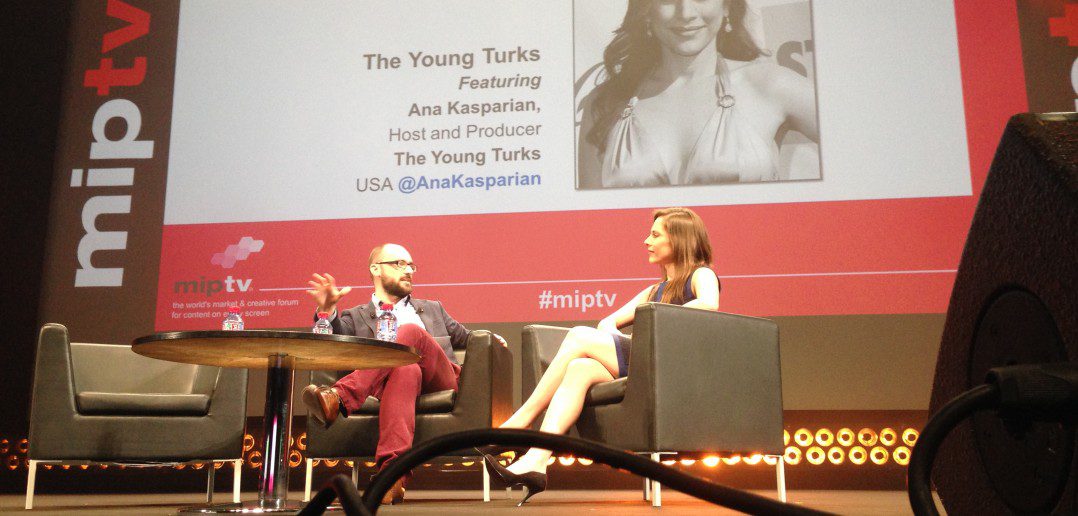This first-ever session of the inaugural MIP Digital Fronts was opened by Amber J. Lawson, CEO of Comedy Gives Back, who proclaimed, “It is an industry trend, what YouTube has created: the democratisation of content.”
Michael Stevens, creator of VSauce UK and host of the YouTube segment, showed us five channels that have enjoyed enormous growth on YouTube and are producing formats of value to millennials and brands.
First up, star producers Rhett & Link (full names: Rhett McLaughlin and Link Neal – interview here!)
“How do you maintain high output with a small staff?” Stevens asked.
“We’ve found that it’s helpful to inject espresso directly into our necks every morning,” replied Rhett, deadpan.
“I use a vein that’s right here,” said Link, pointing to his temple. “There’s nothing like making a track-mark joke to get started.”
After the laughs, they got down to the serious stuff. One of their most popular videos is The Nerd vs Geek Epic Rap Battle, which has generated nearly 10 million views… and which, it turns out, is branded content.
“It was sponsored by Tiger Direct,” said Rhett. “They wanted to do something to reach their demo: people who care about technology, think of themselves as geeks or nerds. We came up with [Nerd vs Geek] based on what they wanted to accomplish as a brand, and filmed it at their store. It was great money for us, but very cheap for them.”
“Brands fuel our work and give us budgets to create things we wouldn’t otherwise create,” said Link. “See the pillows flying around in our [trailer]video? That was sponsored by a pillow manufacturing company. They gave us a check and a budget, but they also gave us a truckload of pillows. It’s a win-win scenario.”
On brand trust, and preventing people from turning against them, “there’s always been a commitment to create better content with brands involved,” said Link. “There’s no backlash because we’re not trying to pull the wool over people’s eyes” Rhett & Link are up-front, and they build brand content from the ground up.
JacksGap, with Finn & Jack Harries, came next. The pair are exceptional in their production of longer-form YouTube videos, around 15 minutes each.
“YouTube is different from TV,” said Jack. “People are engaged with you as a person, and also your story. It’s incredibly important to bring them along in that story.”
“We started to push,” Finn added. “We learned how to raise capital, and learned how to use camera equipment in ways we didn’t before.”
Stevens asked how they’ve managed to maintain engagement with longer-form content, which agencies tend to advise creators against.
“Average engagement of those people is 13 minutes of a 15 minute episode,” said Finn, who admitted that, when their videos started getting longer, they didn’t really know what would happen.
But even their own YouTube consumption has evolved. Jack used to watch quick sketches and short videos, like everyone else. “Now,” said Jack, “I come to YouTube with 15 minutes or half an hour, but I’m coming with a higher level of engagement. I think YouTube’s headed that way 100%; people stay engaged for longer periods of time.”
A new form of Millennial-stye news reporting followed JacksGap, with Ana Kasparian presenting The Young Turks (pictured above).
“There’s this misconception that young people have no interest in the news,” she began. “We discovered they do want to be informed, but they want to be informed by people they can relate to.”
The US is especially problematic: “They have these great anchors that are smart, but they’re not talking to people; they’re reading from a teleprompter. People want to feel as though they’re part of the conversation. I think TYT manages to do that.”
But the model stands on the shoulders of its viewers, and she never forgets it. “Our audience is a huge part of our content. Their engagement is important to us; they immediately tell you what they like and don’t like. They’re holding you accountable. If you want a genuine audience that sticks around and is loyal, you have to listen to their feedback.”
News consumption style is also a generational issue that TYT — and YouTube — are sensitive to. “We have lots of great stuff to put on this great platform, so people who don’t have the time to watch it live can watch it later, on demand. That’s another way Millennials are different: they want their news on demand.”
She concluded by reinforcing her first point. “It’s really important, for news specifically, to not be scripted. No teleprompter. Remember that people want to relate.”
Adrien Labastire, representing Golden Moustache (now a property of French channel), came up next.
Since Golden Moustache’s acquisition by M6, it can expand operations but must maintain the explosive, universal standard of humour that it proliferated in the first place. According to Labastire, Golden Moustache wants to “take those values and bring them to other business areas.”
And their ambitions aren’t small. “We want to become a leading brand content agency. That’s our business objective.”
He talked about the Web Comedy Awards, created in partnership with Orangina. This “Academy Awards for the Web” was simultaneously broadcast on TV and online, and featured not just popular French comedians but YouTubers as well.
“The idea was to create a 360° show,” said Labastire. You had the red carpet on YouTube, and another angle, and then an aftershow on YouTube. The idea was that people could see the ceremony from different angles.”
Sponsorship from Orangina enabled them to push the limits of their creativity for the broadcast. “There’s not much you can do in a TV show, it’s very regulated in France. So all creative initiatives were done on YouTube,” he said.
Last on the list was sports channel Copa90, headed by Eli Mengem.
Mengem’s passion for football can be felt throughout the room. “This is more than a game. This is a cultural movement,” he said.
“Football is so international, it just doesn’t end. I’m off to Serbia next week. My passport is three-quarters full in 11 months. 11 months ago I was working at a bar, I was a student,” he gushed.
He called his job a dream job. “The reason people warm to me is because I’m truly about the fans. Ever since I got into football, I always found it more fascinating to see what was happening off the pitch.” There is so much content to produce, he said.
Stevens closed the session with a reflection on what YouTube has to offer content producers, and on the difference between “Audience” and “Fan”.
“The scale of audience available on YouTube is gigantic,” he said. “You can build a really big audience on YouTube, but an audience is just sort of there. They show up and listen. A fanbase is going to subscribe and watch everything you make. They’re gonna tell your friends about you.”
More from the MIP Digital Fronts today and tomorrow, only on MIPBlog!
Be sure to read our exclusive Vast Media white paper “Multi-channel Networks”! Download here (email required)




